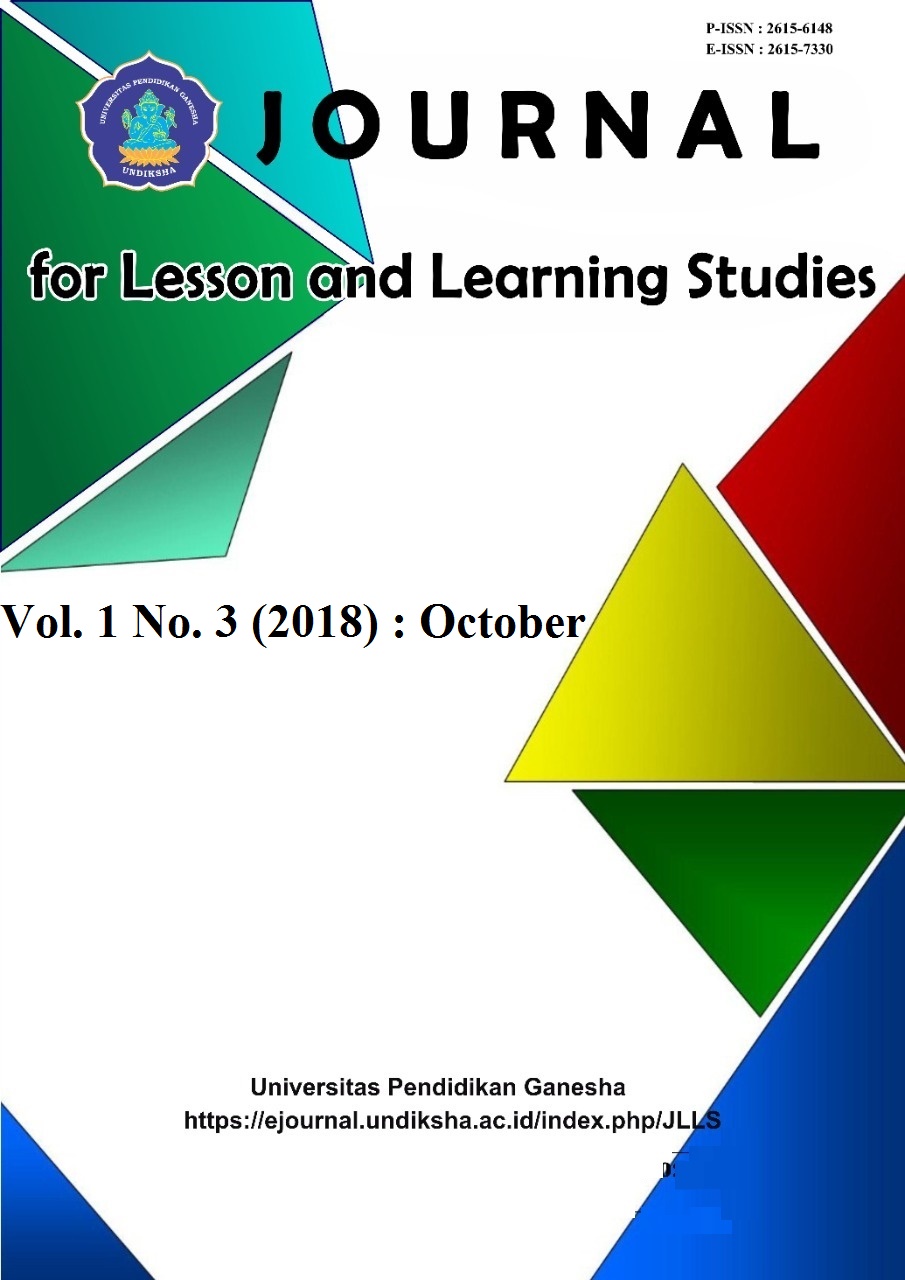PENERAPAN HIGH ORDER THINKING SKILL DALAM MODEL PEMBELAJARANSMALL GROUP DISCUSSION UNTUK MENINGKATKAN HASIL BELAJARPPKN KELAS 5 SEKOLAH DASAR
DOI:
https://doi.org/10.23887/jlls.v1i3.14763Abstract
Abstrak
Penelitian ini bertujuan untuk meningkatkan hasil belajar PPKn kelas 5 SD melalui penerapan HOTS dalam model pembelajaran Small Group Discussion. Metode penelitian yang digunakan adalah PTK (Penelitian Tindakan Kelas).Teknik pengumpulan data menggunakan tes, observasi, dan studidokumen. Instrumen yang digunakan adalah lembar observasi aktivitas guru, lembar observasi aktivitas siswa, dan tes hasil belajar.Teknik analisis data yang digunakan yaitu deskriptif kualitatif dan kuantitatif.Subjek penelitian adalah kelas V SDN Sumogawe 03 Kabupaten Semarang Tahun Ajaran 2017/2018.Hasil penelitian menunjukkan bahwa dengan penerapan High Order Thinking Skill dalam model pembelajaran Small Group Discussion dapat meningkatkan hasil belajar PPKn siswa.Secara klasikal hasil belajar PPKn siswa mengalami peningkatan dengan persentase nilai yang diperoleh pada siklus I persentase yang diperoleh sebesar 50% dan siklus II sebesar 70%. Sehingga, dapat disimpulkan bahwa penerapan High Order Thinking Skill dalam model pembelajaran Small Group Discussiondapat meningkatkan hasil belajar PPKnkelas 5 Sekolah Dasar.
Kata Kunci: High Order Thinking Skill,Small Group Discussion, Hasil Belajar, dan PPKn.
ABSTRACT
This research aims to improve the results of studying Pancasila and Citizenship Education of the fifth grade of primary school through the HOTS application within a learning model of Small Group Discussion. The research method used is CAR (Class Action Research). The collection of data technique uses test, observation, and documents’ study. The instruments used are observation sheets, teacher activity, observation sheets of student activity, and the test of studying results. The analysis of data technique used i.e. qualitative descriptive and quantitative. The subject of research is the fifth grade students of National Elementary Schools of Sumogawe 03 Semarang Regency, school year 2017/2018. The results of research shows that with the application of High-Order Thinking Skills within the learning model of Small Group Discussion is able to improve the results of studying Pancasila and Citizenship Education of the student. Classically, the result of studying Pancasila and Citizenship Education of the student getting an improvement with a values’ percentage obtained on the first cycle at 50% and on the second cycle at 70%. So that, it is inferential that the application of High-Order Thinking Skills within the learning model of Small Group Discussion is able to improve the results of studying Pancasila and Citizenship Education of the fifth grade student of the elementary school.
Key Words:High-Order Thinking Skills,Small Group Discussion, the results of the study, andPancasila and Citizenship Education.
References
Alma, Buchari. 2009. Guru Profesional Menguasai Metode dan Terampil Mengajar.Bandung: Alfabeta
Anderson, Lorin W. & Krathwohl, David R. 2010.Kerangka Landasan Untuk Pembelajaran,Pengajaran, dan Asesmen. Yogyakarta:Pustaka Pelajar.
Arends, Richard I. 2008. Learning To Teach (Belajar Untuk Mengajar).Yogyakarta: Pustaka Pelajar.
Ariandari, Peindy P. 2015. Mengintegrasikan Higher Order Thinking dalam Pembelajaran Creative Problem Solving.Seminar Nasional Matematika. Halaman 489-496. Universitas Negeri Yogyakarta
Brookhart, S. M. (2010). How to Assess Higher Order Thinking Skillss in Your Class-room. Alexandria: ASCD.
Dasar dan Struktur Kurikulum Sekolah Dasar/ Madrasah Ibtidaiyah.
Degeng, Nyoman S. 2013. Ilmu Pembelajaran: Klasifikasi Variabel untuk Pengembangan Teori dan Penelitian. Bandung: Kalam Hidup.
Ennis, R.H. 1985. Goal for a Critical Thinking Curiculum, Developing Minds: a Resource Book for Teaching Thinking. Virginia. ASDC.
Ennis, R.H. 2001. Critical Thinking Assesment.Theory Into Practice, 32 (3): 179-186.
Hanafiah, Nanang., Cucu Suhana. 2012. Konsep strategi pembelajaran. Bandung: PT REFIKA ADITAMA.
Hasibuan dan Moedjiono, Proses Belajar Mengajar, (Bandung: Remaja Rosdakarya, 2000), hlm. 20.
Heong, Y.M, et al. (2011). The level of Marzano higher order thinking skillss among technical education students.International Journal of Social Science and humanity.Vol 1, No. 2. pp 121-125.
Huda, Miftahul. 2013. Model-model Pengajaran dan Pembelajaran. Yogyakarta: Pustaka Pelajar.
Ibrahim, Muslimin, dkk. 2000. Pembelajaran Kooperatif. Surabaya: UNESA
Ismail, Strategi Pembelajaran Agama Islam Berbasis PAIKEM, (Semarang: RaSail Media Group, 2008), hlm. 87-89
Jakarta: Kemdikbud.
Joyce, Bruce. dkk.. (2009). Model of Teaching Model-model Pengajaran.Yogyakarta: Pustaka Pelajar.
Kemdikbud. 2013. Permendikbud Nomor 67 Tahun 2013 tentang KerangkaKencana
Krathwohl, David R. 2002. “A Revision of Bloom’s Taxonomy: An Overview”, Theory Into Practice, Volume 41, Number 4, Autum 2002. Ohio: College of Education, The Ohio State University.
Lewy, Zulkardi, Nyimas, A. 2009. Pengembangan Soal Untuk Mengukur Kemampuan Berpikir Tingkat Tinggi Pokok Bahasan Barisan dan Deret Bilangan di Kelas IX Akselerasi SMP Xaverius Maria Palembang. Jurnal Pendidikan Matematika, Volume 3 Nomor 2. 2009. Universitas Sriwijaya Palembang.
Munadi, Yudhi dan Farida Hamid. 2009.Strategi dan Model-Model Pembelajaran Aktif, Inovatif, Kreatif, Efektif, dan Menyenangkan. Jakarta: FakultasTarbiyah dan Keguruan (FITK) UIN Syarif Hidayatullah
Nitko, A.J. & Brookhart, S.M. (2011). Educational Assessment of Student (6th ed). Boston: Pearson Education.
Nur, Muhammad. 2005. PembelajaranKooperatif. JawaTimur :Depdiknas.
Oemar Hamalik, Proses Belajar Mengajar, (Jakarta: Bumi Aksara, 2008) hlm. 91
Rusman. 2012. Model-Model Pembelajaran Mengembangkan Profesionalisme Guru. Jakarta: Rajagrafindo Persada
Saur Tampubln, Penelitian Tindakan Kelas Sebagai Pengembangan Profesi Pendidik dan Keilmuan, Jakarta: Erlangga, 2014.
Schraw, Gregory et al. (2011). Assessment Of Higer Order Thinking Skillss. America: Information Age Publishing.
Slameto. 2003. Belajar dan Faktor-faktor yang Mempengaruhinya. Jakarta : PT Rineke Cipta.
Slavin, Robert E. 2010.Cooperative Learning Theory, Research and Practice. Bandung: Nusa Media
Sudjana, Nana. 2011. Dasar- dasar Proses Belajar Mengajar. Bandung: Sinar
Sugiyono. 2009. Metode Penelitian Pendidikan: Penelitian Kuantitatif, Kualitatif,dan R&D. Bandung: Alfabeta.
Suprijono, Agus. 2012. Cooperative Learning. Surabaya: Pustaka Belajar.
Sutawidjaja, A. dan Jarnawi A.D. 2011.Pembelajaran Matematika. Jakarta: Universitas Terbuka.
Trianto. (2009). Mendesain Model Pembelajaran Inovatif-Progresif: Konsep, Landasan, dan Implementasinya pada Kurikulum Tingkat Satuan Pendidikan (KTSP). Jakarta: Kencana
Trianto, 2010.Mendesain Model Pembelajaran Inovatif Progresif.Jakarta :
Turmuzi, Ahmad. 2013.Mengingat dan Memahami Kembali tentang Teori Taksonomi Bloom.
Wijaya Kusuma dan Dedi Dwitagama, Mengenal Penelitian Tindakan Kelas (Jakarta: Indeks 2012)
Downloads
Published
How to Cite
Issue
Section
License
Authors who publish with the Journal for Lesson and Learning Studies agree to the following terms:
- Authors retain copyright and grant the journal the right of first publication with the work simultaneously licensed under a Creative Commons Attribution License (CC BY-SA 4.0) that allows others to share the work with an acknowledgment of the work's authorship and initial publication in this journal.
- Authors are able to enter into separate, additional contractual arrangements for the non-exclusive distribution of the journal's published version of the work (e.g., post it to an institutional repository or publish it in a book), with an acknowledgment of its initial publication in this journal.
- Authors are permitted and encouraged to post their work online (e.g., in institutional repositories or on their website) prior to and during the submission process, as it can lead to productive exchanges, as well as earlier and greater citation of published work. (See The Effect of Open Access)




